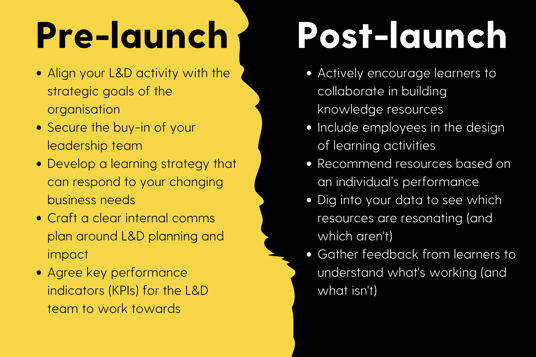If the COVID-19 pandemic showed organisations one thing, it was the capacity of employees to adapt to new ways of working in double-quick time.
In the post-pandemic world, many organisations have retained the changes they made in the wake of global lockdowns and social distancing restrictions. While those days are behind us (for now), businesses recognised the huge benefits of the flexible new ways of working, with almost 40% of Brits working from home at least some of the time in 2023.
Now we've settled into our remote and hybrid working models, a question is emerging for HR teams: how do we build a healthy learning culture to keep our employees resilient and adaptable, no matter what comes next? And as an added challenge, how do we do that even when our people are working all over the place?
The history of learning culture
It was Peter Senge’s book, the Fifth Discipline, that introduced the concept of a 'learning organisation', one which continually adapts and thrives based on the continuous development of employee capabilities. Essentially, success comes from individuals’ commitment and capacity to learn. And it is this learning at all levels within the organisation that is a characteristic of a learning culture.
Creating learning cultures – assessing the evidence, a research report from the Chartered Institute of Personnel and Development (CIPD), says:
“A learning culture is one that embeds learning into how things are done at an individual, team and organisational level.”
But just because these were some of the earliest mentions of the concept, the reality is that learning cultures have always existed. Much like everyone has an accent, every organisation has a learning culture, whether it's never been considered or a key part of the L&D strategy.
So if you've never come across the concept before, what actually is a learning culture?
What is a learning culture?
As well as embedding learning at an individual, team and organisational level, the CIPD’s report states that leaders must reinforce the strategic importance of learning for the entire organisation, providing a 'shared vision and positive change through open dialogue and reflection'.
And it's through dialogue and reflection that organisations learn from their mistakes. According to Nigel Paine, author of Workplace Learning – How to build a culture of continuous employee development. In this book, Nigel outlines three key components to building a learning culture:
- The ability to learn from mistakes
- The ability to learn from outside the organisation (such as identifying and acting on market trends)
- Developing employees who are confident to learn and ask questions to drive continuous improvement
Put simply, a good learning culture enables organisations to continuously learn, adapt and thrive. And in today’s environment, this is exactly what organisations are looking to do – adapt and thrive.
Learning culture vs. learning environment
'Learning culture' as a concept is quite hard to pin down. It's not exactly tangible, which can make it difficult for people to understand how it applies in their own business.
What is more tangible, though, is a learning environment. They may sound similar, but there are some important differences Put simply:
- A learning culture is a set of consistent behaviours, expectations and attitudes
- A learning environment covers the practical considerations, such as the technology and having the time and space to learn
Without the right environment for learning, a learning culture can't work. If the learning culture is the foundation of your learning strategy, the learning environment is the ground upon which the culture is built. You need the right tools, enough time and suitable spaces (whether that's physical locations or digital platforms) for learning, or there's nowhere for your learning culture to grow.
To quote our CLO Steve Thompson:
"You can have the most expensive Ferrari, but if you live in a town where the maximum speed limit is 20mph, what's the point? You'll never be able to maximise the value of your investment."
In other words, if you're pouring time and effort into building an amazing learning culture, but there's not a suitable time or place for your people to engage in learning, you're not going to get very far. That's why before you get started on your learning culture, you need to make sure the fundamentals of your learning environment are in place, which means:
- Having the right technology, such as learning platforms, comms tools and assessment tools
- Dedicating time to learning, whether that's an hour a week or a day a quarter solely reserved for brushing up on new skills and knowledge
- Creating suitable spaces for learning, which could be quiet 'learning labs' in the office or collaborative digital platforms for knowledge sharing and peer-to-peer learning
What does a positive learning culture need?
In its study of high-performing learning cultures, Mind Tools revealed six habits that drive successful learning cultures. They are:
- Clarity of purpose
- Holistic people experience
- Thriving ecosystem
- Agile, digital infrastructure
- Continual engagement
- Intelligent decision-making
Organisations displaying these habits 'achieve at least ten times more sustainable impact on growth, transformation, productivity and profitability, and higher levels of soft skills that fuel these cultures such as resilience, innovation, motivation, critical thinking and agility.' And who doesn't want that, right?
It's also useful to understand what a good learning culture might look, sound and feel like. For instance, do you have the right technology and tools to support learning? Do people talk about learning positively? Do people have the psychological safety they need to experiment and make mistakes without repercussions? Spotting these signs will help you understand the health of your own learning culture.
The business impact of a learning culture
So, if we think about Mind Tools' research report and the huge impact that a learning culture can have on growth, transformation, productivity and profitability, as well as equipping employees with the right soft skills to succeed, it's clear that getting your learning culture right can have a huge impact on your business - including the bottom line.
A learning culture emphasises the importance of learning and of continuous improvement. That means individuals are trusted to do their job well and to explore how they could do it better, rather than being told what to do. For many businesses, this approach will represent a dramatic change in working culture - but there are considerable rewards for businesses bold enough to take the leap.
.png?width=449&height=299&name=Learning%20culture%20(1).png)
There are also some more subtle benefits that organisations should consider. The Mind Tools research reveals that staff retention is improved in 71% of high impact learning cultures (HILCs) vs. 24% of non-HILCs. Additionally, 91% of HILCs say their learning initiatives are delivered in time to meet the needs of the business vs. 41% of non-HILCs.
These are behaviours that are moving the needle. They're not just learning interventions, and what’s more, behaviours do not cost anything to develop. But that’s the rub. Developing a learning culture has a bigger impact on organisational performance than other learning interventions, but you can’t just buy one. Instead, it takes time and effort to nurture a learning culture and, crucially, to make it stick.
How to develop your learning culture
Developing a learning culture isn't going to happen overnight. It won't happen in a month, or even six months. In fact, the work to maintain your learning culture never stops. But the rewards for putting the effort in are huge.
The advice for building your learning culture can be broadly split into two camps: pre-launch and post-launch. Pre-launch learning culture activities focus on planning and alignment, whereas post-launch activities are to do with leveraging your internal comms to create sustainable momentum - otherwise the culture will fizzle out, leaving you back where you started.
With that in mind, take a look at our top tips for developing your learning culture!

Who does what?
At the organisational level, L&D must work closely with the business' senior leadership team to create a learning culture that aligns with the overall business goals, as well as the wider company culture. This alignment is key to achieving real organisational change, rather than creating a learning culture that supports learning objectives alone. An open dialogue, reflection and honest feedback are all essential for underpinning your learning culture.
Getting more granular, at the team level, L&D should empower managers to act as facilitators of learning. Or, to put it simply: stop getting in the way of learning. Managers have the ability to block off time in calendars for learning, to recommend and approve learning opportunities (such as conferences and training workshops) and set up mentoring programmes... so do it!
Individual learners should feel encouraged to suggest and share learning opportunities with their managers and teammates, as well as actively engaging in peer-to-peer learning. That could mean sharing useful resources on the learning and comms platform, discussing their area of expertise in a lunch and learn session or even just participating in brainstorming sessions about how to solve a particular business problem. It's the job of the HR and L&D team to ensure that the company culture and learning culture prioritise psychological safety to support collaboration and knowledge sharing.
Ready to level up your learning culture?

It is commonly said that culture is 'the way things are done around here'. That might seem a simplistic explanation of what can be the most effective approach to organisational learning. It’s easy to say, but far harder to make happen.
But what we can say with certainty is that developing a fit-for-purpose learning culture is more than worth the investment in time and effort. Your learning culture becomes the vehicle for learning to happen at all levels of the organisation. It enables individuals, teams and the entire organisation to thrive, even during times of huge change, setting you up for success no matter what's around the corner.
